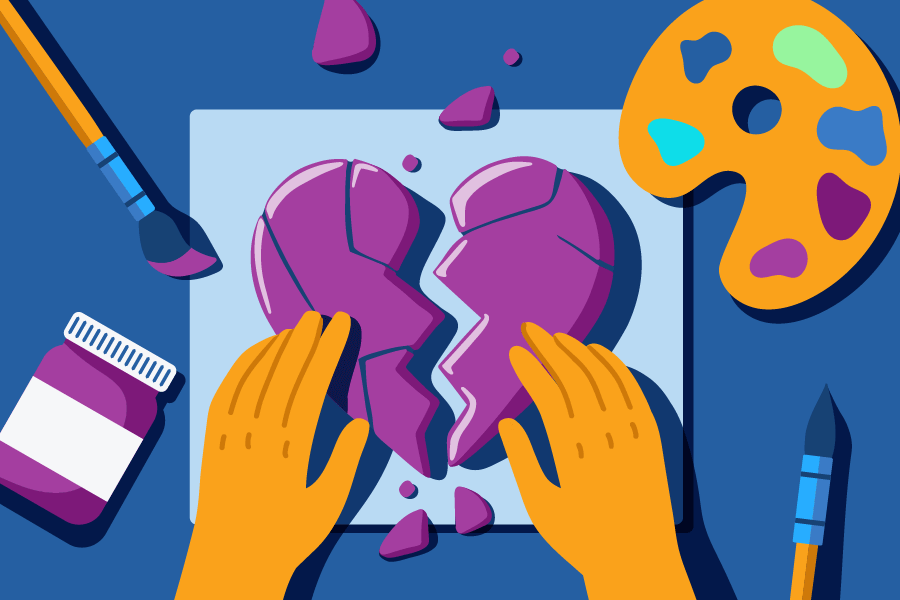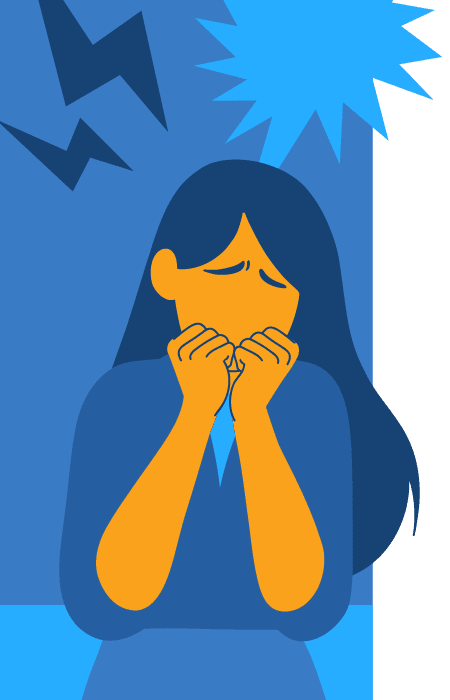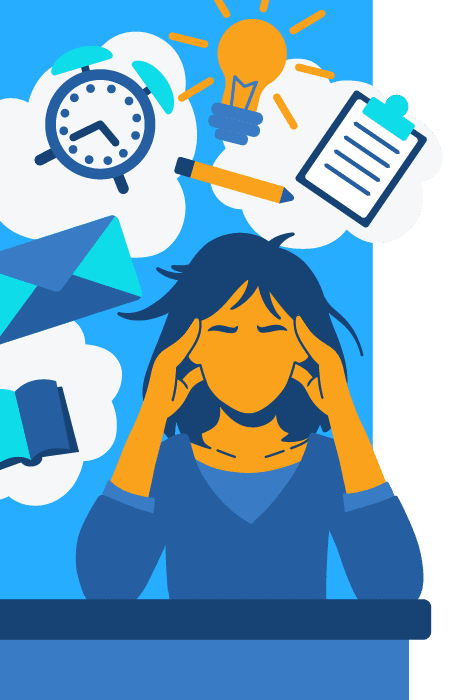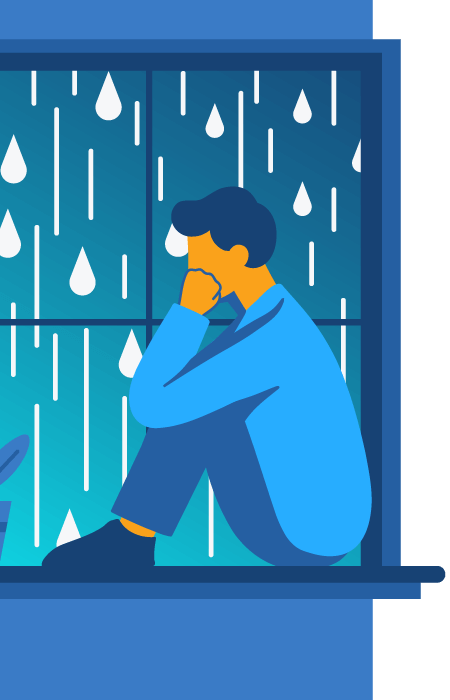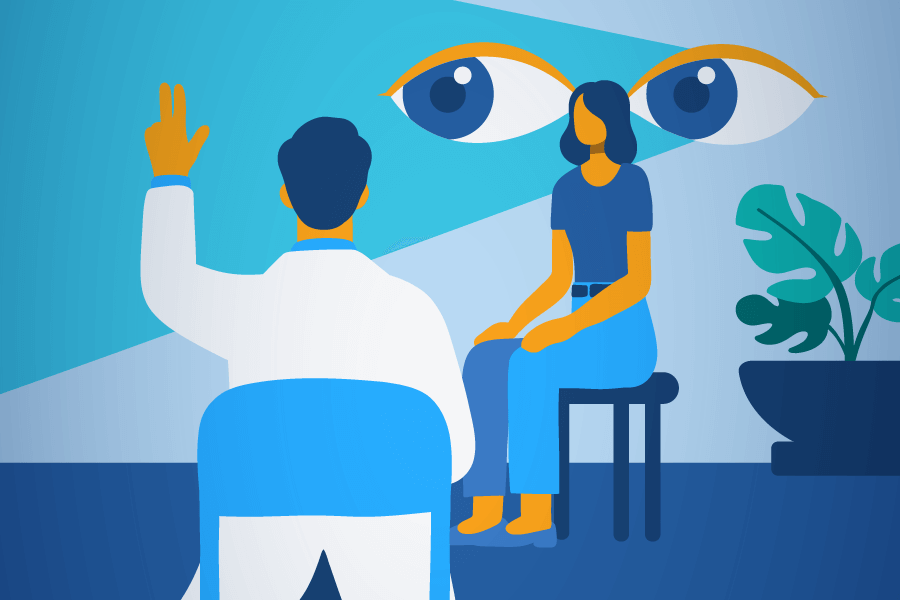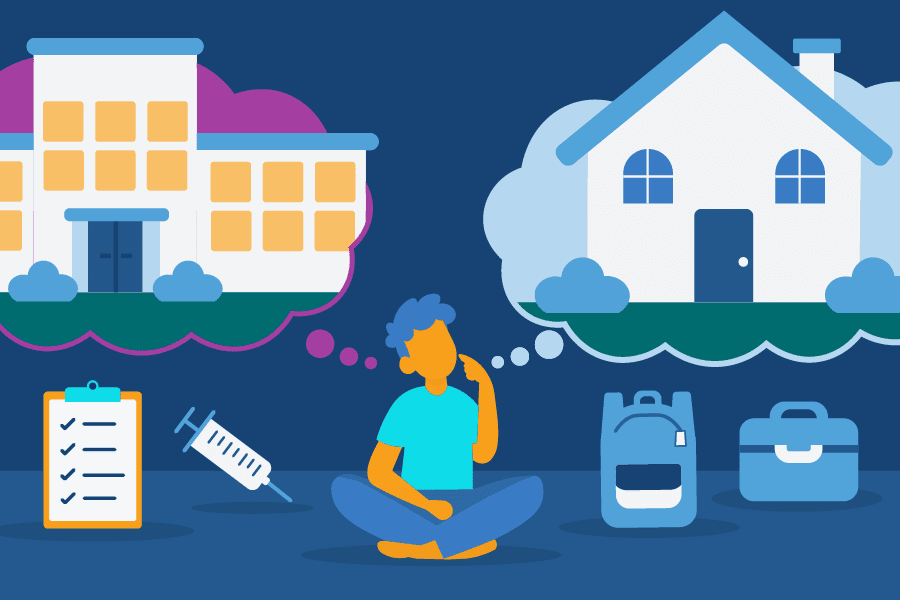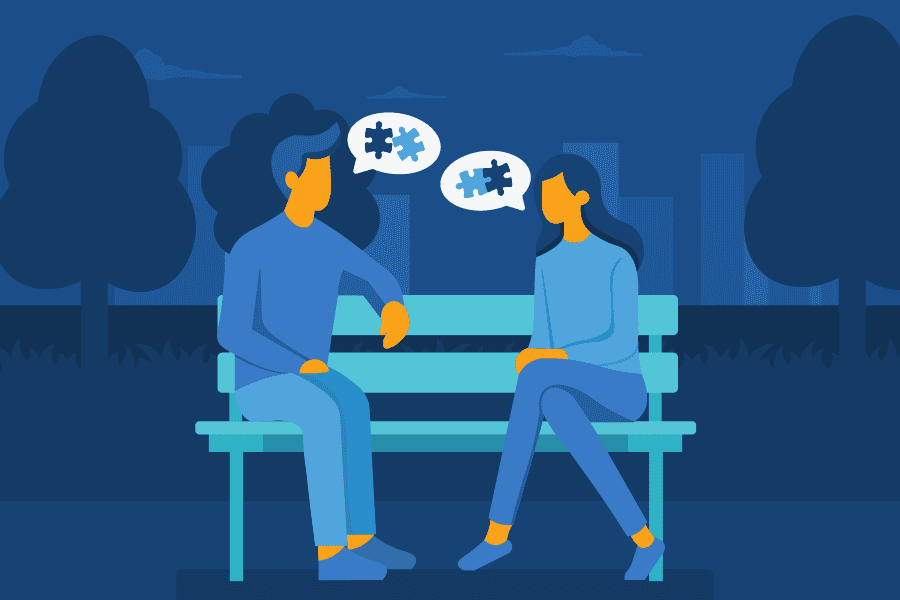Introduction to Art Therapy
What Is Art Therapy?
Art therapy is a form of psychotherapy that uses creative processes, such as drawing, painting, and sculpting to help individuals express and explore their thoughts, emotions, and experiences.
Therapy can be intimidating, especially at first. This can make it hard for people to open up about difficult life experiences or their struggles with mental illness for a long time.
During that warm-up period, many people abandon therapy altogether, or think that it just isn’t right for them.
Art therapy helps speed up the process, which helps more people find treatments that actually work to help them with addiction, trauma, anxiety, and so much more.
Unlike traditional talk therapy, art therapy doesn’t require talking to be the main outlet for self-expression.
This makes it particularly beneficial for individuals who find it difficult to articulate their feelings through words.
How Does Art Therapy Work?
Art therapy works by bridging the gap between the brain and the emotions we feel through the creative process.
When individuals create art, it activates multiple areas of the brain, including those involved in visual processing, motor skills, and emotional regulation.
This combination helps bridge the gap between conscious and unconscious thoughts, allowing people to express feelings they may not be able to verbalize.
With art therapy, one can express one’s emotions, thoughts, and behaviors through art, helping one gain more insight into oneself and release and feel less shame.
A typical art therapy session lasts up to two hours.
The first 15 to 30 minutes are spent warming up – this time allows them to interact and discuss what may have happened between now and their last session.
After this, 45 minutes to an hour are spent on the art project.
With art therapy, a therapist can help a person figure out what they want to address in therapy and what their goals are.
From there, they can help the individual choose a medium or method of art that can help them express themselves and, later on, talk about the art and the process to gain more clarity and understanding.
Art therapy works as a tool to connect both the body and the mind.
Is Art Therapy Evidence–Based?
Yes. There is growing evidence that art therapy can be helpful for mental health challenges.
In a variety of studies, creative art therapy is associated with positive effects, specifically with symptoms surrounding anxiety, depression, trauma, low mood, distress, and low self-esteem.
There are also ways for art therapists to become board-certified with organizations such as the Art Therapy Credentials Board (or the ATCB), to help guarantee that they are using the most well-researched interventions available.
What Are the 3 Things Present During Art Therapy?
The three things present during art therapy are the artist, the therapist, and the artwork.
Through art-making, the artist, therapist, and artwork work together to help uncover and process emotions.
For an example with visual arts, someone dealing with grief might paint a tree with broken branches.
At first, they might just say, “It’s a tree in winter,” but when the therapist asks, “Why the broken branches?” they start to realize that those branches are reflecting something about how they are feeling.
The artwork gives a clear starting point for talking about feelings that might otherwise be hard to explain with words.
With the therapist’s help, the person can make sense of their grief and figure out ways to cope and move forward.
Why Do Therapists Use Art Therapy?
A therapist may use art therapy to improve the mental health and relationships of their clients.
Types of Art Therapy
What Is Art Therapy Used For?
Art therapy is used for a wide range of challenges, including managing stress, coping with anxiety and depression, processing trauma, and improving self-esteem.
It can also help individuals work through grief, develop better emotional regulation, and enhance communication skills.
For example, art therapy can be helpful for children with behavioral or social challenges at school or for older adults who are severely stressed or facing challenges with their mental health.
Art therapy can be an effective form of treatment for individuals experiencing developmental, educational, medical, social, or psychological challenges.
Beyond mental health, art therapy is often used in medical settings to support those dealing with chronic illness or pain, such as cancer patients.
Art therapy is helpful in those cases because it provides a space of self-advocacy for expressing complex feelings related to their condition.
Art Trauma Therapy
How to Heal Trauma With Art?
Healing trauma with art involves using creative techniques like drawing, painting, or sculpting to process traumatic memories and emotions in a way that feels safe.
Talking about trauma can be overwhelming, especially in the early stages of healing.
When someone tries to verbalize their traumatic experiences, it can trigger intense emotions, such as fear, shame, or helplessness, causing them to relive the trauma.
This process, known as retraumatization, may lead to emotional shutdown or dissociation, where the individual feels numb or disconnected as a way to protect themselves from further pain.
Art therapy offers a safer alternative by allowing individuals to express their trauma without relying on words.
Creating art provides a degree of emotional distance, letting people process their feelings gradually and at their own pace.
For example, instead of directly recounting a traumatic event, they might use colors, shapes, or abstract forms to represent their emotions.
This indirect approach feels less threatening and can help them access and work through difficult feelings without becoming overwhelmed.
What Is Art PTSD Therapy?
Art PTSD therapy is a form of treatment that uses creative activities like drawing, painting, or sculpting to help individuals cope with the symptoms of post-traumatic stress disorder (PTSD).
PTSD often involves intrusive memories, flashbacks, and intense emotional responses to reminders of trauma.
This can lead to symptoms such as anxiety, panic, memory lapses, reactivity, or emotional numbness.
Talking about these experiences can feel overwhelming or even retraumatizing, especially in the early stages of therapy. Art provides a way to approach these memories more safely.
For example, a veteran with PTSD might struggle to describe the details of a traumatic event in words but could start by painting a battlefield scene in muted, dark colors.
This allows them to externalize their experiences without having to relive them verbally.
Over time, the therapist helps the individual explore the emotions and thoughts behind the artwork, gradually guiding them to process the trauma in a way that feels manageable.
It is common for people to hold the weight of trauma in both their minds and bodies, and PTSD can impact a person’s everyday life and functioning.
Talk therapy is commonly used to help treat PTSD. However, art therapy offers a way for individuals with PTSD to express themselves in creative ways and release feelings that they might have bottled up.
Art Therapy for Anxiety
How Does Art Therapy Help With Anxiety?
Psychiatry studies show that art therapy is effective in reducing anxiety symptoms, helping with emotion regulation, and improving quality of life.
It can be difficult to understand and cope with the feelings that anxiety can bring up. Additionally, it can also be hard trying to explain to someone or talk about how you feel.
Art therapy can help an individual with anxiety express their emotions or process certain experiences. It can also help relieve stress and promote mindfulness and being present in the moment.
Art Therapy for ADHD
How Does Art Therapy Help With ADHD?
Art therapy helps individuals with ADHD by improving focus, emotional regulation, and self-expression through creative, hands-on activities.
People with ADHD often struggle to stay still or process their emotions, but art offers a productive outlet where they can move freely and make their own choices.
The sensory experience of working with materials like clay or paint engages different parts of the brain, helping to calm the nervous system and improve attention.
By channeling emotions into visual form, art also helps reduce impulsivity and makes communication easier.
Over time, these practices build skills in focus, emotional awareness, and self-regulation in a way that feels natural and supportive.
Art Therapy for Depression
How Does Art Therapy Help With Depression?
Art therapy can help with depression because it can help those suffering to express difficult emotions like sadness and hopelessness that are common in depression.
With art therapy, people can express themselves in unique ways, and they might feel less shame or judgment compared to talking to someone.
Art therapy can also help open up a conversation and a safe space to make someone more comfortable talking.
Art therapy can also help with a person’s self-esteem and confidence and allow them to try something new.
Art Therapy for Addiction
How Does Art Therapy Help With Addiction?
Art therapy has been shown to have positive associations when combined with other forms of addiction treatment, like 12-step programs, for treating substance use disorders.
Art therapy can help individuals in addiction recovery by providing a safe space for them to express themselves and understand their feelings and experiences better.
Benefits of Art Therapy
What Are the Benefits of Art Therapy?
Some of the benefits of art therapy can include:
- Self-expression
- Stress management
- Emotion release
- Confidence and improved self-esteem
- Communication and social skills (especially in group therapy)
- Promotes a comfortable and safe environment
- Encourages creative expression
- Provides an opportunity to open up a new conversation
- Self-awareness
- Processing stressful events
- Improving cognitive functions
- Managing chronic mental health and medical conditions
- Improves quality of life and overall well-being
Who Benefits the Most From Art Therapy?
Art therapy can be beneficial for:
- Adults experiencing increased levels of stress
- Individuals who have experienced trauma
- Children experiencing behavioral or social challenges
- Children with autism
- Children with learning disabilities
- Individuals with brain injury
- Individuals experiencing mental health challenges
FIND OUT IF ART THERAPY CAN HELP YOU TODAY
Call (888) 850-1890 to begin finding the best route for healing your family.
How Does Art Therapy Affect the Brain?
Art is seen as a multi-process activity, which means it interacts with many different parts of the brain.
Creating art is linked to multiple regions in the brain, and expressive modalities like art therapy can help use those connections to improve symptoms.
Art therapy engages multiple areas of the brain, promoting emotional healing and cognitive growth.
When creating art, the brain activates regions responsible for visual processing, motor skills, and decision-making.
At the same time, it engages the limbic system, which regulates emotions and memory. This dual activation helps individuals process complex emotions, especially those tied to trauma or stress, in a safe and non-verbal way.
Creating art also stimulates the release of dopamine, a neurotransmitter associated with pleasure and motivation, which can improve mood and reduce anxiety.
Focusing on the creative process helps quiet the amygdala, the brain’s fear center, reducing the fight-or-flight response and promoting a sense of calm.
Over time, these changes can lead to improved emotional regulation, enhanced problem-solving abilities, and greater self-awareness.
By engaging different parts of the brain and giving space for a person to communicate non-verbally, the creativity that art therapy fosters helps stimulate a person’s mind and allows them to process information and feelings in different ways compared to talking about it.
Art therapy can also help to reduce stress and calm down the brain, helping people with depression, anxiety, and mental health challenges.
What Hormones Are Released During Art Therapy?
The process of creating art can help release feel-good neurotransmitters such as dopamine and serotonin while at the same time reducing levels of cortisol, which is a stress hormone.
Risks of Art Therapy
What Are the Disadvantages of Art Therapy?
One of the disadvantages of art therapy that has been discussed is the challenge of bringing up emotions and memories that were not resolved.
For example, if a person is taking part in art therapy, and a work of art brings up emotions that they have not addressed or have suppressed for a long time, it can be overwhelming and difficult to cope with.
One way to address this disadvantage is by making sure you have the proper support and find an art therapy program that works for you to ensure that you have a professional helping you along the way.
What Are the Limitations of Art Therapy?
A potential limitation of art therapy is that it might cause higher levels of stress or anxiety.
While in the therapeutic process of creating art, a person might be faced with certain emotions or memories that can be overwhelming and difficult to process.
The process of working through these things through art can be overwhelming and stressful for some.
What Are the Negative Effects of Art Therapy?
A negative effect of art therapy can include increased anxiety or stress.
Art therapy might not work for everyone, and creative processes used in art therapy might be stressful for some or not as successful as other forms of treatment.
This is why it is best to reach out for professional help to help you decide the best options for you and to help guide you if you find that a certain treatment method is not helpful.
Art Therapy Activities
What Is an Example of Art Therapy?
Common examples of art therapy can include:
- Painting
- Doodling
- Drawing
- Collage-making
- Sculpting
- Photography
- Working with clay
- Music therapy
- Dance therapy
What Is Scribble Drawing Art Therapy?
Scribble drawing is when a person draws on paper with crayons, markers, pens, or pencils without thinking about it and drawing spontaneously.
Scribble drawing can help to take the stress and pressure off of the feeling that a person has to create art in a certain way or make something look perfect. It can also help uncover certain anxieties or emotions without overthinking them.
What Is the Blob and Wet Paper Technique?
The blob and wet paper technique starts with a slightly wet piece of paper.
You can then use a marker, ink, or paint and add drops to the paper. After, you can crumple the paper, lay it flat out again, and repeat the process until you feel done. Some people also add other art materials that provide texture, such as glitter or more paper.
When you’re done, you might discuss with a therapist or other people in a group what your art might mean, or what it might make you feel.
How to Get Started With Expressive Arts Therapy
How Do I Start an Art Therapy Session?
If you are trying to learn more about art therapy, it is important to reach out to a professional, whether a healthcare professional or a mental health professional, to talk about different programs and how to start.
The first session of an art therapy program involves establishing a relationship, trust, and comfortable space between the individual and the therapist.
Art therapy sessions can start by discussing the individual’s goals, what supplies they are comfortable with, what art they might want to try, or anything they might be concerned about.
For the individual, it is helpful to start art therapy with an open mind and ask questions if you feel unsure about it.
Can You Do Art Therapy on Your Own?
Many people may benefit from using art at home to manage stress, promote relaxation, and foster creativity.
However, if a person is facing challenges with their mental health or other underlying issues, it is important to reach out for professional help and to do art therapy with the help of the right therapist.
If a person does art therapy on their own, it can bring up unexpected and overwhelming emotions and situations that can be difficult to cope with without the help of professional support.
What Age Is Art Therapy Good For?
Art therapy can benefit young children from age two through adulthood.
Studies have shown art therapy to be beneficial particularly for adolescents because it is seen as a less threatening or overwhelming form of treatment compared to traditional talk therapies.
It can be difficult for anyone to talk about their challenges or experiences. However, young people, in particular, might find art therapy more appealing because they can communicate things through art that they might be ashamed of, too embarrassed to talk about, or not know how to talk about.
How Long Does Art Therapy Take?
Sessions of art therapy themselves typically last anywhere from 50 to 90 minutes.
It is common for people to take 8 to 15 weeks to complete art therapy; however, the amount of time it takes to finish a program can depend on various factors, including the individual’s needs and the treatment program they are in.

